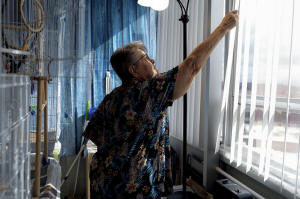Trump administration halts $1 billion program that keeps aging
affordable housing livable
[March 12, 2025]
By JESSE BEDAYN
The Trump administration is halting a $1 billion program that helps
preserve affordable housing, threatening projects that keep tens of
thousands of units livable for low-income Americans, according to a
document obtained by The Associated Press.
The action is part of a slew of cuts and funding freezes at the U.S.
Department of Housing and Urban Development, largely at the direction of
President Donald Trump and Elon Musk's Department of Government
Efficiency, that have rattled the affordable-housing industry.
Preserving these units gets less attention than ribbon-cuttings, but
it's a centerpiece of efforts to address the nation's housing crisis.
Hundreds of thousands of low-rent apartments, many of them aging and in
need of urgent repair, are at risk of being yanked out from under poor
Americans.
The program has already awarded the money to projects that would upgrade
at least 25,000 affordable units across the country, and details of how
it will be wound down remain unclear.
A spokesperson for HUD did not respond to repeated requests for comment.
But an internal document reviewed by the AP said that the program is
being “terminated” at the direction of DOGE. Two HUD workers, who have
knowledge of the program and spoke to the AP on the condition of
anonymity for fear of reprisal, confirmed the directive to shutter it.
On it's face, the over $1 billion Green and Resilient Retrofit Program,
passed by Congress in 2022, is intended for energy-efficiency
improvements. It is distributed in grants and loans to owners of
affordable housing in need of updating, including replacing or repairing
heating and cooling systems, leaky roofs, aging insulation or windows,
or undertaking floodproofing.

But the money plays a much larger role in preserving affordable units.
Projects that use the funds are required to keep their buildings
affordable for up to 25 years. The money is also leveraged to pull in
other investments for major repairs and renovations needed to keep the
buildings livable.
It's like building a Jenga tower, where one of the program's grants or
loans — which range from hundreds of thousands to millions of dollars —
is a bottom block and each new block is another investment, experts
said.
This money “was essential in order for the project to come together,”
said Mike Essian, vice president at American Community Developers, Inc.,
which received funding for several affordable housing projects.
“Projects will fail and these are projects that are already difficult to
finance.”
The news has been a jolt to Al Hase and Joan Starr, tenants in an
apartment building in Vancouver, Washington, full of other low-income
seniors with few or no other options — most of whom live on less than
$33,000 a year.
[to top of second column]
|

Phyllis Goss opens the window blinds for her birds inside her studio
apartment at Smith Tower Apartments on Monday, March 10, 2025, in
Vancouver, Wash. (AP Photo/Jenny Kane)

The 170-unit Smith Tower Apartments, built in the 1960s, is in need
of updates, including it's first building-wide sprinkler system. The
$10 million award was a financial kickstart for its nearly $100
million project, and is cited in applications for other investments.
The potential loss “seriously jeopardizes our ability to be able to
provide an upgrade to the current systems,” said Greg Franks,
president of the property’s management company, adding that the work
is "needed to sustain the livability of this building based on its
age, and to keep it viable for another 60 years.”
“We are depending on that $10 million,” he said.
So, too, are Hase and Starr, a retired couple in their 70s who have
lived there for 16 years.
They fill their balcony with geraniums and petunias, count the
eagles at a nearby park and live off of meager Social Security
incomes. They learned about the potential funding loss in a letter
from the apartment's management company.
“It’s kinda terrifying, it’s almost like getting news from a doctor
that something's going to take your life in six months or a year,”
Hase told the AP in a phone call.
“We're from an era where the wages weren't there, so our Social
Security ...” he said, pausing. “Sucks,” pitched in Starr.
“If I'd been born a rich man,” he said. Starr added: “We’re just
regular people.”
“And we're the lucky ones because we've got two social securities
coming in," she said.
But being lucky ones still doesn't count for much in today's rental
market. “Prices keep going up, I've looked, and there's no way," she
said.
“It’s the difference between living and not being able to live," he
said.
HUD's lack of communication about the program's future sent
organizations in search of contingency plans, though roughly two
dozen projects will still get funding, one HUD employee told the AP.
The rest are in limbo.
“If these funds aren’t reinstated, we will certainly seek other
funding to fill that gap. The reality is that will take time and
will inevitably make the project more expensive,” Travis Phillips of
the Housing Development Center said of funding for Smith Tower.
It's the position several hundred other affordable-housing projects
now find themselves in across 42 states, the District of Columbia
and Puerto Rico.
“In all honesty,” said Michelle Arevalos, Smith Tower's
administrator, “if this building were not here, a lot of our folks
actually probably would be homeless.”
All contents © copyright 2025 Associated Press. All rights reserved |